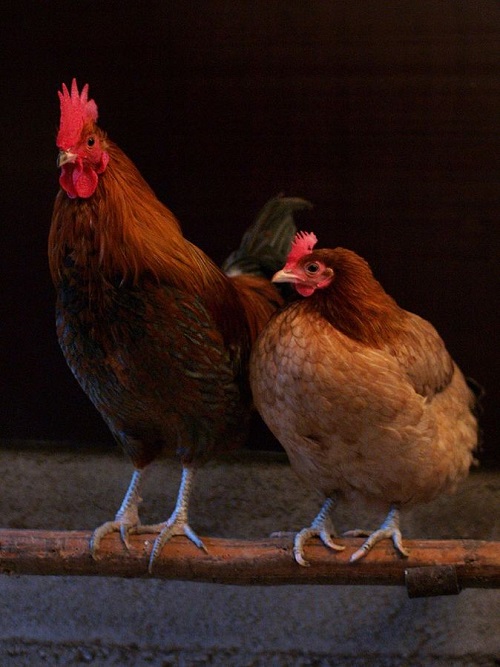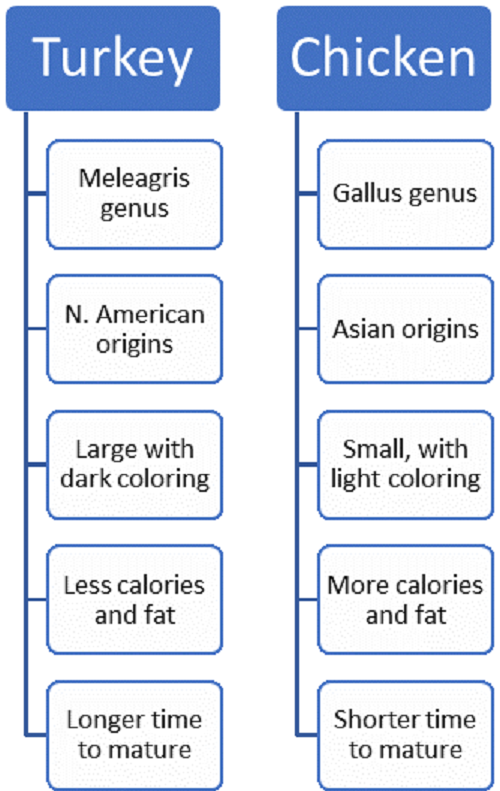Difference between Turkey and Chicken
Turkeys and chickens are both edible fowl that are commonly found in many areas. Their flavor is similar, but there are still many differences between the two birds.
- Taxonomy
Turkeys and chicken share a similar taxonomy, and are the same up until the subfamily category. Both belong to the Animalia kingdom, the Chordata phylum , the Aves class, and the Galliformes order. However, the turkey is in the Phasianidae subfamily, with the genus being Meleagris. There are two distinct species-Meleagris gallopavo, which is the common domestic or wild turkey, and the Meleagis ocellata, or the ocellated turkey which is native to the Yucatan Peninsula in Mexico.
Like the turkey, the chicken also belongs to the Animalia kingdom, the Chordata phylum, the Aves class, and the Galliformes order. However, it is a part of the Phasianinae subfamily, the Gallus genus, and the subspecies pf Gallus gallus domesticus. This is the species commonly known as the domesticated chicken.
- History
Turkey fossils have been found beginning in the Early Miocene era onward, all of which originated in North America. They were imported into Europe primarily by merchants from the country of Turkey, which is how they became known as turkey birds or turkeys.
The domestic chicken is descended from the red junglefowl and they were first domesticated for cockfighting in Asia, Africa and Europe. There is a claim that they were first domesticated in Southern China as early as 6000 BC, but it is not clear as to whether those birds are actually related to the modern domestic chicken. They were considered a rare food in ancient Greece, but breeding of chickens increased under the Roman Empire, and they were also considered to be a sacred animal and were used as oracles. There is still a lack of data as to how the chicken spread to many regions of the world, but it has become a staple food source in many different counties.
- Appearance
Turkeys and chickens are relatively easy to distinguish based upon their physical appearance and characteristics. Turkeys are larger in size than chickens, usually by about 10 to 15 pounds, and will have very long tail feathers. They are also darker in color than chickens with no feathers on their neck and head. Turkey eggs are a tan or brown color.
Chickens are usually smaller than turkeys. The hens can be colorful or white, with roosters having striking plumage with long flowing tails and shiny, pointed feathers on their necks and backs. These feathers are usually a brighter color than what is found on hens. Roosters also have a large comb on the top of their head, hanging flaps of skin on either side of their beak called wattles, and will develop spurs on their legs. Chickens will have feathers on their head and necks, and their eggs are typically white in color.
- As food
Both turkeys and chickens are eaten in many different areas of the world. They do have different flavors as well as nutritional differences. The meat from both birds contains vitamin B6 and niacin, which may be helpful in protecting against Alzheimer’s disease and general age-related mental decline. Both B6 and niacin can help support energy metabolism in the body. Turkey is relatively low in saturated fat and contains riboflavin, phosphorous, protein and selenium. It also contains the antioxidant zinc, which is useful as an immunity booster and helps regulate endocrine function and hormone levels. Turkey meat does have high cholesterol and sodium levels though. It is commonly eaten throughout the year in the US and Canada, and is the traditional meal served at Thanksgiving.
Chicken tends to have more calories, fat, and cholesterol than turkey, but it also contains more omega fatty acids and protein. The typical serving of chicken breast meat contains about 165 calories, while turkey breast meat contains only 104. Chicken has less sodium and is also a good source of phosphorus, and selenium. Selenium can improve the body’s immune system when fighting against bacterial and viral infections, against cancer cells and the herpes virus. It also increases the good cholesterol, HDL, resulting in healthier heart function. Like turkey, it is also high in cholesterol.
- Rearing
Turkeys are generally wild, although raising them in domestic environments is becoming increasingly common. Commercial varieties of turkeys are also fast-growing. They require a high-protein diet. The modern turkey is a hybrid that is larger than wild varieties. This typically requires artificial insemination in commercial operations, which also allows for selective breeding with more females selected than males. This will lead to higher rates of hatchability. For breeding stock, the poults (baby turkeys) will be raised under environmentally-controlled conditions for 28 weeks, during which time the females grow to be about 24-30 pounds while the males will grow to 50-70 pounds. At 28 weeks, the females will typically begin producing eggs and will lay for about the next 26 weeks. In that time, they will lay about 100-130 eggs. The eggs are incubated and hatched. Once they reach a desired weight, the birds are transported for processing.
Most chickens are also raised in a commercial setting for their meat and eggs. They mature at a faster rate than turkeys, taking only about 14 weeks to reach a size in which they could be processed. Chickens can also lay more eggs than turkeys, with some hens being able to lay over 300 eggs per year. Some chickens are kept as pets.
- Difference between Condition and Warranty - October 21, 2017
- Difference between Monetary and Nonmonetary Assets - September 26, 2017
- Difference between Turkey and Chicken - September 16, 2017
Search DifferenceBetween.net :
1 Comment
Leave a Response
References :
[0]Turkey (bird). (n.d.). On Retrieved from https://en.wikipedia.org/wiki/Turkey_(bird)
[1](n.d.). On Wikipedia. Retrieved from https://en.wikipedia.org/wiki/Chicken
[2]Modern turkey industry. (n.d.). on PennStateExtension. Retrieved from http://extension.psu.edu/animals/poultry/topics/general-educational-material/the-chicken/modern-turkey-industry




Thank you for teaching me the difference between chicken and turkey!